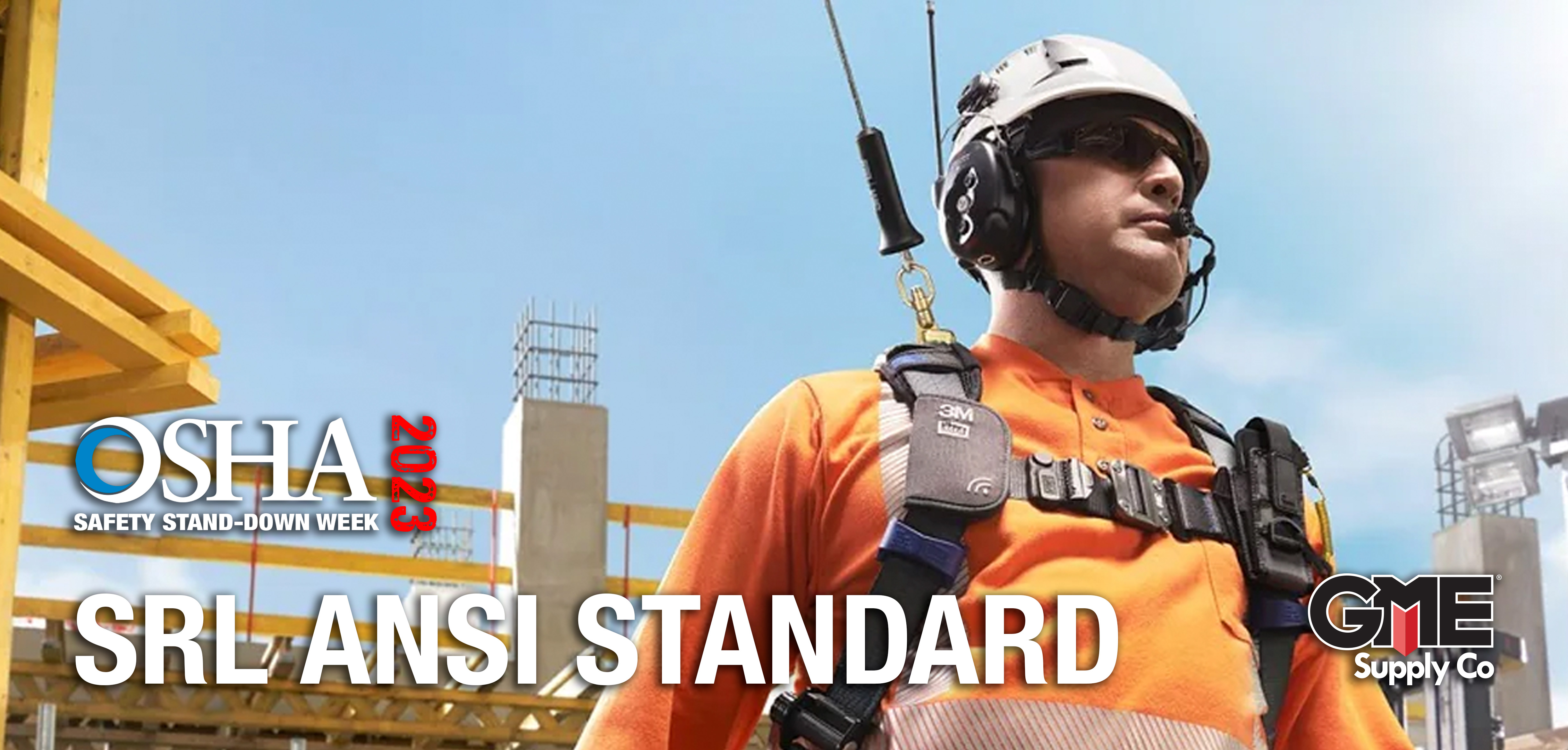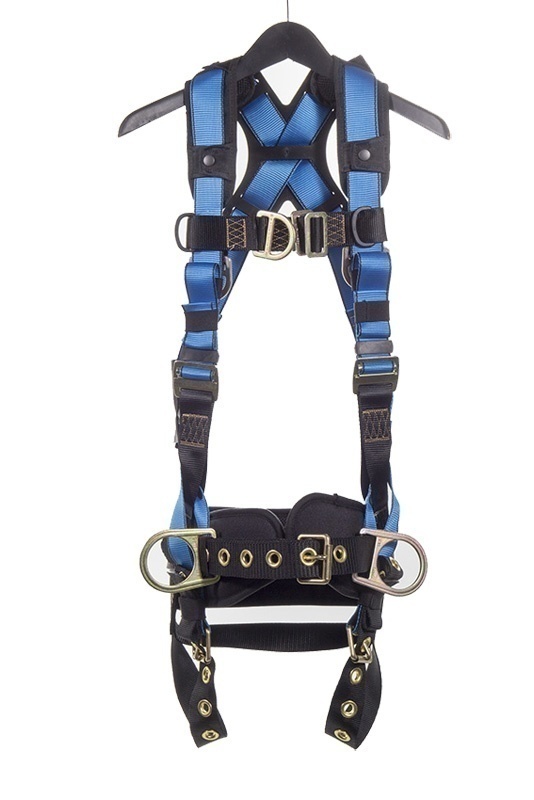YOU HAVE NO ITEMS IN YOUR CART.
Featured Brands
GME Supply Safety Stand-Down Week 2023: It's the Standard
Day One
ANSI/ASSP Z359.14-2021 SRD Standard Updates

The New Standard in SRDs
Standard changes aren’t all that uncommon, but understanding what the new standards mean and how they effect your job site can make all the difference.
June 17th, 2021: The American National Standard for the Safety Requirements for Self-Retracting Devices (SRDs/SRLs) was approved. August 01, 2023: This new standard (ANSI/ASSP Z359.14-2021) officially goes into effect.
Starting August 1st, 2023, the new Z359.14-2021 standard will supersede any corresponding requirements in: ANSI Z359.14-2014, Z359.1, Z359.3, and Z359.4
It’s important to note that any SRL products manufactured to the previous revisions of ANSI Z359.14 can continue to be purchased and used as originally intended after 08/01/2023 as long as it was manufactured prior to the effective date of the new standard.
What changes were made?
The following changes will have to be met for any SRD to meet the new standard:
- Test mass increased from 282 lbs (128 kg) to 310 lbs (140 kg).
-
New SRL categories have been designated.
- SRL
- SRL-P (NEW) for Personal SRLs
- SRL-LE (REMOVED) and designated as Class 2
-
SRL Classifications 1 and 2 created and replacing the 2014 standard of Class A and Class B.
- Class 1 SRLs are for use with anchorages at or ABOVE the dorsal D-ring and the maximum freefall is not to exceed 2 feet.
- Class 2 SRLs are for use with anchorages at or BELOW the dorsal D-ring with a maximum allowable freefall that does not exceed 6 feet.
- Class 2 devices that utilize webbing and synthetic rope must now have an MBS of 5,000 lbs (22.2kN).
- An integral energy absorber is now required on the lifeline for all Class 2 devices. The energy absorber must meet all Z359.14 requirements or independently meet the Z359.13 requirements. *Note: SRL-P devices that have the device attached to the dorsal D-ring instead of anchorage does not require an energy absorber on the lifeline - but the SRL must provide a way to dissipate the arresting force.
- All Class 2 devices require labels showing a fall clearance table and diagram of the axes shown in the table. The labels must be attached to the product. While not required - it is preferred that the labels are at or near the harness attachment point.
- All SRLs must meet new static strength testing requirements. The updated test requires that an SRL handles a 3,600 lb (16kN) static load for one minute with the lifeline fully extracted.
- SRLs that do not incorporate an internal braking system must hold a minimum 1,800 pounds (8kN) static load while the brake pawls or other brake activation system is engaged and locked with at least 75% of the lifeline constituent remaining on the drum assembly.
- Any SRL that doesn’t have a internal breaking system must hold a minimum of an 1,800 lb (8kN) static load while the brake pawls or other breaking system is engaged and locked with at least 75% of the lifeline remaining on the drum assembly.
- SRL-P devices that have been designed to be tied-back or wrapped around anchorage must hold a load of 3,600 lbs (16kN) after 2,500 cycles of abrasion testing where the lifeline was wrapped around an I-beam.
- Class 2 and SRL-P devices DON’T need to retract after overhead dynamic performance tests.
- A clearance requirement label must be included on all Class 2 SRL-P devices.
-
During ambient dynamic performance testing utilizing a 310 lb (140kg) test mass, the average arresting force (AAF) permitted has been increased from 900 lbs (4kN) to 1350 lbs (6kN). The arrest distance (AD) has been shortened to 42 inches (1,067mm).
For the conditioning tests, AAF remains at 1575 lbs (7kN), but the AD is now 42 inches (1,067mm). Arrest Distances overall have been reduced from 54 inches (1,372mm) with conditioning temperatures and times remaining same as the previous standard requirements. - SRL-P devices are required to pass a dynamic performance test. During this test the SRL-P device must keep the MAF of a 310 lb (140 kg) weight with a 6 foot (1.8 m) free fall at 1,800 lbs (8 kN) or less.
- Class 2 devices are required to pass a dynamic test over an edge. During this test a 310 lb (140 kg) weight is used.The Class 2 device must keep the AAF at or below 1,350 lbs (6 kN), MAF cannot exceed 1,800 lbs (8 kN) ambient, and AAF 1,575 lbs (7kN) conditioned.
- SRL-R tests are the same as Z359.14 except that the static testing when in retrieval mode has been increased to 3,600 lbs (16kN)
- SRLs with internal brakes must pass a test with the lifeline shortened to 42 inches (1,067mm), then have 36 inches (914mm) +/- 1.0-inch (25mm) clipped out, then have a 310 lbs (140 kg) weight free falling 2 feet (.6m) and must maintain MAF at 1,800 lbs or less.
- SRL-P and Class 2 devices can only have up to 48 inches (1,219mm) of line outside the SRL housing when fully retracted down from 60 inches (1.5m).
- A warning card that is provided as a separate card must be included with each SRL.
Questions or Need More Info?
If you have any questions regarding the above information or need more insight into safety or fall protection in general, reach out to our Gear Experts®! Click here to contact our team, or use the instant chat feature in the lower right hand corner of your browser screen. Also be sure to connect with us on social media to keep up with all of our latest content.












